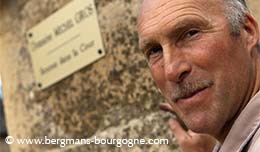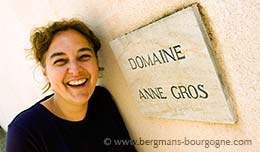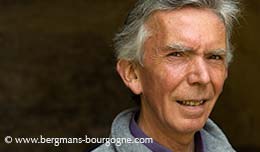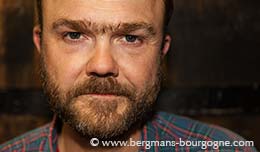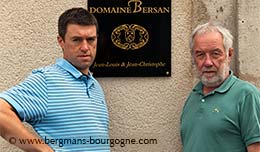
here was a time when Domaine Collotte in Marsannay-la-Côte only had three hectares of vineyards. In recent years it has grown considerably. In 2015 there was 13 hectares under vines. In 2016 there was 15 hectares and in 2017 17 hectares.
– 17 hectares is about as much as we can handle, says Isabelle Collotte. There is a limit to what we can do with our resources and still do a good job.
It was Isabelle Collotte’s grandfather who created the domaine. Like many at the time he did not focus only on wine. He had other crops as well and kept animals.
 – The vineyards he had were Bourgogne Marsannay, as the appellation was at the time, says Isabelle Collotte. The village appellation for Marsannay was created in 1987. My father quit school when he was 16 years old and began working at the domaine. He wasn’t interested in anything but the vineyards, so eventually he got rid of the other crops and the animals. Instead he started taking on more vineyards.
– The vineyards he had were Bourgogne Marsannay, as the appellation was at the time, says Isabelle Collotte. The village appellation for Marsannay was created in 1987. My father quit school when he was 16 years old and began working at the domaine. He wasn’t interested in anything but the vineyards, so eventually he got rid of the other crops and the animals. Instead he started taking on more vineyards.
1979 was the first vintage to be bottled at Domaine Collotte. Prior to that everything had been sold off in bulk to négociants.
– I arrived at the domaine in 2013, says Isabelle Collotte. I came directly from wine school. This has really been a new beginning for the domaine, with all the work my father has put in and with all the vineyards that have been added in recent years.
 You’ll find the majority of the 17 hectares at Domaine Collotte in and around Marsannay. In Marsannay there is red, white and rosé, as well as regional appellations. There is Fixin in white and red, and there is both Gevrey-Chambertin and Chambolle-Musigny.
You’ll find the majority of the 17 hectares at Domaine Collotte in and around Marsannay. In Marsannay there is red, white and rosé, as well as regional appellations. There is Fixin in white and red, and there is both Gevrey-Chambertin and Chambolle-Musigny.
– Our Bourgogne blanc is mainly from Champforey, says Isabelle Collotte. There is a small part from En la Caillée, but the soil there is the same as in Champforey. Both are close to the village of Marsannay. You’ll find Champforey to the immediate east of the village (but still west of the Dijon-Beaune road) and En la Caillée just south of the village. Champforey is a very nice place. The only problem is in dry years, when the vines might suffer from water stress. The vines are between 30 and 40 years old.
 The white Marsannay of the domaine comes from three parcels, in En Blungey, Les Etalles and Poiset. The wine is vinified half in tank, half in barrel.
The white Marsannay of the domaine comes from three parcels, in En Blungey, Les Etalles and Poiset. The wine is vinified half in tank, half in barrel.
– The white Fixin is different, continues Isabelle Collotte. It’s vinified 100 per cent in barrels, with a quarter of new oak. We produce four barrels, so one is new, one has been used for one wine, one has been used for two and one for three. Fixin is a completely different terroir compared with Marsannay. A white Marsannay will have more fat.
In red the choices for Marsannay are wider at Domaine Collotte. There is the old vines cuvée, a blend from several parcels, and five single vineyard wines – Les Champsalomon, En Combereau, Les Boivins, Le Clos de Jeu and Les Grasses Têtes. All five vineyards are located fairly close to each other. The first two are at the northern end of the commune of Couchey, while the remaining three are just across the border in the commune of Marsannay.
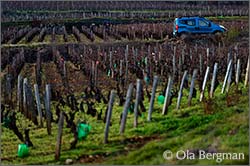 – The old vines cuvée is mainly from Les Etalles and Les Rosey, with a bit of Les Grasses Têtes and Les Favières. The average age of the vines is 50 years. It’s a wine which is meant to be drunk young. Like all our reds it’s completely de-stemmed. The difference here is that there is a cold pre-fermentation maceration. Not very long and above all no punching down. This wine is made to be round and fruity, enjoyable straight away. The wine is made 50 per cent in tank and 50 per cent in barrel. We don't extract too much tannin and we avoid too much oak.
– The old vines cuvée is mainly from Les Etalles and Les Rosey, with a bit of Les Grasses Têtes and Les Favières. The average age of the vines is 50 years. It’s a wine which is meant to be drunk young. Like all our reds it’s completely de-stemmed. The difference here is that there is a cold pre-fermentation maceration. Not very long and above all no punching down. This wine is made to be round and fruity, enjoyable straight away. The wine is made 50 per cent in tank and 50 per cent in barrel. We don't extract too much tannin and we avoid too much oak.
 For all the remaining reds it is 100 per cent in barrel. Only one type af barrel is used, all with the same typ of toast. By creating homogeneous conditions they feel it is easier for each terroir to express itself.
For all the remaining reds it is 100 per cent in barrel. Only one type af barrel is used, all with the same typ of toast. By creating homogeneous conditions they feel it is easier for each terroir to express itself.
– Our Clos de Jeu is more complex. There is one week of cold pre-fermentation maceration. Once fermentation has begun there is punching down. It’s 25 per cent new oak. The vines are 45–50 years old. You’ll find vines from the same generation in Les Boivins. There is a difference in soil and the exposure is different since Les Boivins is on another slope.
 Marsannay is a large appellation. Unlike many other appellations it stretches outside the commune from which it has taken its name. The Marsannay appellation begins in Chenôve, at the outskirts of Dijon, continues across Marsannay down to Couchey, which is bordering on Fixin.
Marsannay is a large appellation. Unlike many other appellations it stretches outside the commune from which it has taken its name. The Marsannay appellation begins in Chenôve, at the outskirts of Dijon, continues across Marsannay down to Couchey, which is bordering on Fixin.
– Since the Marsannay appellation covers three communes you’ll have very different wines, says Isabelle Collotte. In that respect Marsannay differs from other villages along the Côte. In the Côte de Nuits almost all villages have village appellation all the way down to the route nationale. We don’t. We have asked the INAO to change that. There are lieux-dits like Champforey, En Mechalot and En la Caillée. They are all very good and could be upgraded to village appellation.
A bit further down the Côte de Nuits Domaine Collotte has small holdings in both Gevrey-Chambertin and Chambolle-Musigny.
– In 2016 we only had one single parcel in Gevrey-Chambertin, says Isabelle Collotte. En Champs, which is north of the village. From 2017 we have one parcel in Les Evocelles as well. That’s in Brochon. For the Chambolle-Musigny it’s mainly Les Échanges, with a bit of Les Herbus, Les Athets and Les Chardannes. The vines were planted in 1955.
© 2018 Ola Bergman










